Global Surveillance Market, By Component, By Connectivity, By Application, By Industry Vertical, By Region & Segmental Insights Trends and Forecast, 2024 – 2034
- Industry: Technology
- Report ID: TNR-110-1189
- Number of Pages: 420
- Table/Charts : Yes
- June, 2024
- Base Year : 2024
- No. of Companies : 10+
- No. of Countries : 29
- Views : 10140
- Covid Impact Covered: Yes
- War Impact Covered: Yes
- Formats : PDF, Excel, PPT
In Terms of Revenue, the Global Surveillance Market was Worth US$ 41.5 Bn in 2023 and is Anticipated to Witness a CAGR of 9.2% During 2024 – 2034. Surveillance refers to the monitoring of behavior, activities, or information to gather data, often for the purpose of managing, directing, or protecting people and assets. The surveillance market encompasses a wide range of technologies, including CCTV cameras, drones, biometric systems, and advanced software for data analysis and pattern recognition. The market has been experiencing significant growth driven by increasing concerns over public safety, the rise in terrorist activities, and the need for security in commercial and residential areas.
One of the notable trends is the integration of artificial intelligence (AI) and machine learning (ML) into surveillance systems, enabling real-time data analysis and predictive analytics. Advancements in IoT and cloud computing are enhancing the efficiency and scalability of surveillance solutions. Opportunities in the market include the growing demand for smart city initiatives, which require extensive surveillance networks, and the rising adoption of body-worn cameras by law enforcement agencies.
Furthermore, the increasing use of drones for surveillance in various industries presents a substantial growth avenue. Growth drivers include technological advancements, regulatory mandates for enhanced security, and the increasing affordability of surveillance equipment. The market is also propelled by the expansion of smart home devices and the growing awareness of the need for robust security measures in both urban and rural areas.

Surveillance Market Dynamic
Growth Driver-
Increasing Implementation of Smart City Initiatives Globally
As urban areas expand and populations grow, cities are under pressure to enhance public safety, manage resources efficiently, and improve overall quality of life. Smart city projects leverage advanced technologies such as IoT, AI, and big data analytics, with surveillance systems playing a critical role. These projects often include extensive networks of CCTV cameras, traffic monitoring systems, and public space surveillance to ensure security and optimize city operations. Real-time data from these surveillance systems can be analyzed to manage traffic flow, detect and respond to incidents swiftly, and even predict potential security threats. The integration of surveillance technologies into smart city infrastructures is driving substantial demand and innovation in the market, making it a key growth driver.
Trends-
Integration of Artificial Intelligence (AI) and Machine Learning (ML) into Surveillance Systems
These technologies are transforming traditional surveillance by enabling real-time data analysis, facial recognition, and predictive analytics. AI-driven surveillance systems can automatically detect unusual activities or behaviors, reducing the reliance on human monitoring and enhancing response times to potential threats. For instance, AI algorithms can identify patterns and anomalies in video feeds, such as unattended bags in public places or suspicious movements in restricted areas. Additionally, ML models improve over time by learning from new data, increasing the accuracy and reliability of surveillance systems. This trend is not only improving the effectiveness and efficiency of surveillance but also opening up new possibilities for proactive security measures and comprehensive situational awareness across various sectors.
Challenge-
Issue of Data Privacy and Security
As surveillance systems become more advanced and widespread, the amount of data collected grows exponentially. This data often includes sensitive information such as personal identities, behaviors, and movements, raising concerns about how it is stored, accessed, and used. Regulatory frameworks like the General Data Protection Regulation (GDPR) in Europe impose strict guidelines on data handling, requiring companies to implement robust measures to protect privacy.
Non-compliance can result in hefty fines and damage to reputation. Additionally, the risk of cyber-attacks targeting surveillance data is a critical concern. Unauthorized access to surveillance systems can lead to data breaches, compromising both personal privacy and public security. Addressing these privacy and security challenges requires ongoing investment in advanced encryption, secure data storage solutions, and adherence to evolving legal standards, which can be complex and costly for organizations.
Surveillance Market Segmentation by Component, Connectivity, Application, Industry Vertical, Region
Hardware segment by component is set to dominate the surveillance market, commanding a substantial revenue share of 48.2% over the forecast period.
This dominance is driven by the increasing demand for advanced surveillance cameras, sensors, and recording devices. Innovations in hardware technology, such as high-definition cameras, thermal imaging, and panoramic vision, are enhancing the quality and scope of surveillance capabilities. The proliferation of IoT devices and smart city projects necessitates extensive hardware installations, further boosting this segment. The integration of AI and machine learning also relies heavily on sophisticated hardware to process vast amounts of data in real time. As organizations and governments prioritize security and surveillance infrastructure, the investment in high-quality, durable, and efficient hardware continues to grow, solidifying its leading position in the market.
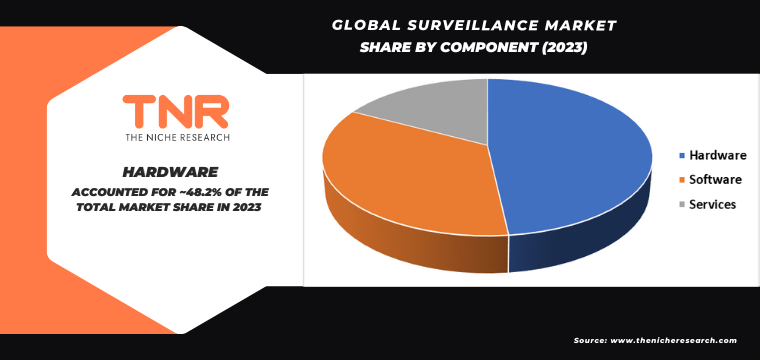
Wireless segment dominated the market and is anticipated to be the fastest-growing connectivity in the surveillance market, capturing a substantial revenue share of 65.5% over the forecast period.
This rapid growth is driven by the flexibility and ease of installation that wireless systems offer compared to their wired counterparts. Wireless surveillance solutions eliminate the need for extensive cabling, reducing installation time and costs, and allowing for easier scalability and reconfiguration. Advances in wireless technology, including improved bandwidth and reliability, have enhanced the performance and security of these systems. Additionally, the growing adoption of smart home devices and the expansion of IoT networks are fueling the demand for wireless surveillance solutions. As more organizations and consumers prioritize seamless and cost-effective security measures, the wireless segment is set to maintain its leading position in the market.
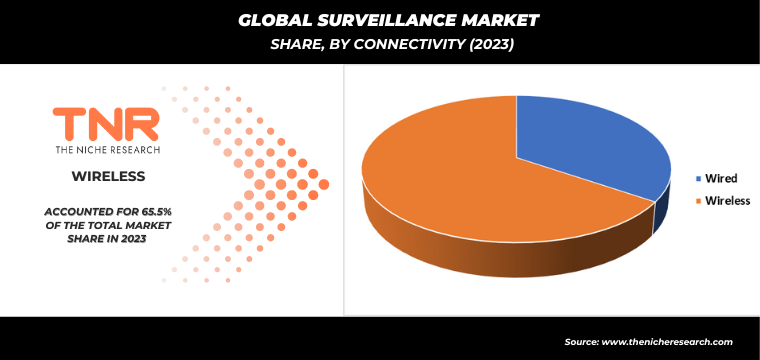
Detection segment by application dominated the surveillance market, accounting for a significant revenue share of 37.7%.
This dominance is driven by the critical role detection technologies play in identifying and responding to potential security threats. Detection applications include motion sensors, facial recognition, intrusion detection systems, and anomaly detection algorithms, all of which are integral to comprehensive surveillance solutions. Advancements in AI and machine learning have significantly enhanced the accuracy and efficiency of detection systems, enabling real-time monitoring and immediate alerts for suspicious activities. The increasing need for robust security measures in various sectors, including commercial, residential, and public spaces, is propelling the demand for advanced detection solutions. As organizations prioritize proactive threat detection and swift response capabilities, the detection segment’s substantial revenue share underscores its vital importance in the surveillance market.
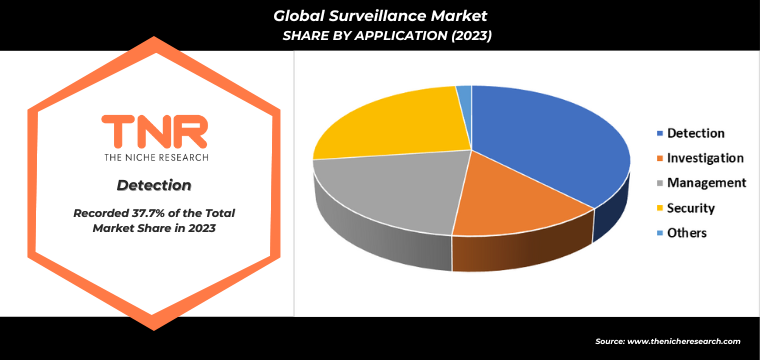
IT and telecommunication is anticipated to be the fastest-growing segment in the surveillance market, capturing a substantial revenue share of 21.1% over the forecast period.
This growth is fueled by the increasing integration of advanced communication technologies and IT infrastructure in surveillance systems. Enhanced connectivity solutions, such as 5G and fiber-optic networks, are enabling faster and more reliable data transmission, which is crucial for real-time surveillance and remote monitoring. Moreover, the proliferation of cloud-based services and big data analytics is transforming how surveillance data is stored, processed, and analyzed. The IT and telecommunication sector’s emphasis on cybersecurity is also critical in addressing the growing concerns over data privacy and protection. As businesses and governments continue to invest in sophisticated surveillance technologies, the IT and telecommunication segment is set to play a pivotal role in driving market growth and innovation.
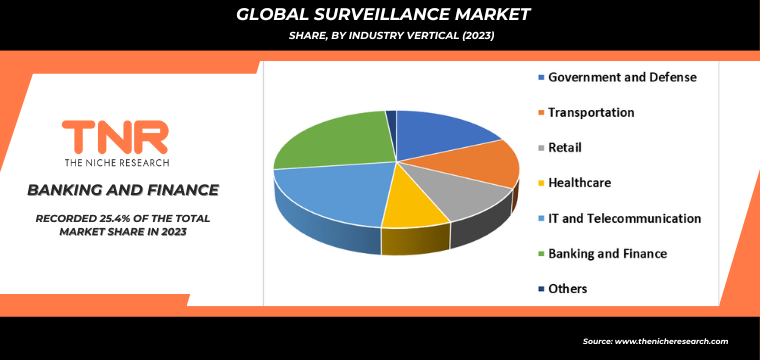
In 2023, Asia Pacific is anticipated to play a significant role in propelling the growth of the surveillance market, contributing approximately 36.1% to its overall expansion.
This region’s rapid urbanization, coupled with increasing investments in smart city projects, is driving the demand for advanced surveillance solutions. Countries like China, India, and Japan are leading the way with extensive deployment of CCTV cameras, biometric systems, and AI-driven surveillance technologies to enhance public safety and security. The rising concerns over crime rates and terrorism are prompting governments and private sectors to strengthen their surveillance infrastructure. The booming e-commerce sector and growing industrialization also necessitate robust security measures, further fueling market growth. As technological advancements continue to emerge and infrastructure development accelerates, Asia Pacific is set to be a key contributor to the surveillance market’s expansion.
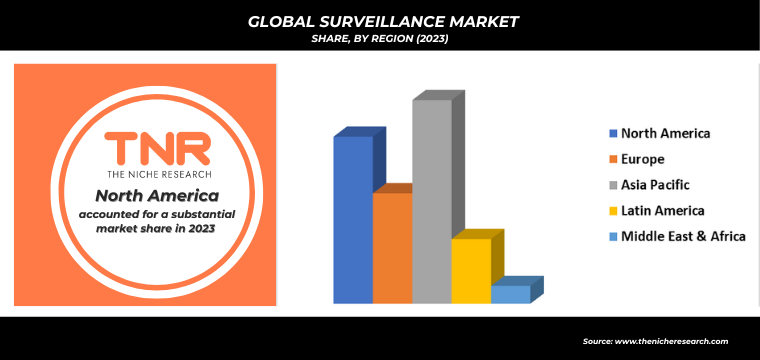
Key Developments
- In January 2024, Consistent Infosystems unveils new line of locally manufactured surveillance cameras.
- In August 2020, TP-Link, a global leader in networking devices and accessories, has introduced VIGI, a dedicated brand focused on video surveillance.
Major Players in Surveillance Market
- Avigilon Corporation
- Axis Communications AB
- Bosch Security Systems
- Dahua Technology
- Flir Systems, Inc
- Hanwha
- Hikvision
- Honeywell Security
- Huawei Technologies
- Panasonic
- Pelco
- Siemens AG
- Tyco
- United Technologies
- Other Industry Participants
Global Surveillance Market Scope
| Report Specifications | Details |
| Market Revenue in 2023 | US$ 41.5 Bn |
| Market Size Forecast by 2034 | US$ 109.2 Bn |
| Growth Rate (CAGR) | 9.2% |
| Historic Data | 2016 – 2022 |
| Base Year for Estimation | 2023 |
| Forecast Period | 2024 – 2034 |
| Report Inclusions | Market Size & Estimates, Market Dynamics, Competitive Scenario, Trends, Growth Factors, Market Determinants, Key Investment Segmentation, Product/Service/Solutions Benchmarking |
| Segments Covered | By Component, By Connectivity, By Application, By Industry Vertical, By Region |
| Regions Covered | North America, Europe, Asia Pacific, Middle East & Africa, Latin America |
| Countries Covered | U.S., Canada, Mexico, Rest of North America, France, The UK, Spain, Germany, Italy, Nordic Countries (Denmark, Finland, Iceland, Sweden, Norway), Benelux Union (Belgium, The Netherlands, Luxembourg), Rest of Europe, China, Japan, India, New Zealand, Australia, South Korea, Southeast Asia (Indonesia, Thailand, Malaysia, Singapore, Rest of Southeast Asia), Rest of Asia Pacific, Saudi Arabia, UAE, Egypt, Kuwait, South Africa, Rest of Middle East & Africa, Brazil, Argentina, Rest of Latin America |
| Key Players | Avigilon Corporation, Axis Communications AB, Bosch Security Systems, Dahua Technology, Flir Systems, Inc, Hanwha, Hikvision, Honeywell Security, Huawei Technologies, Panasonic, Pelco, Siemens AG, Tyco, United Technologies |
| Customization Scope | Customization allows for the inclusion/modification of content pertaining to geographical regions, countries, and specific market segments. |
| Pricing & Procurement Options | Explore purchase options tailored to your specific research requirements |
| Contact Details | Consult With Our Expert
Japan (Toll-Free): +81 663-386-8111 South Korea (Toll-Free): +82-808- 703-126 Saudi Arabia (Toll-Free): +966 800-850-1643 United Kingdom: +44 753-710-5080 United States: +1 302-232-5106 E-mail: askanexpert@thenicheresearch.com
|
Global Surveillance Market
By Component
- Hardware
- Cameras
- Sensors
- Recording Devices
- Others
- Software
- On Premises
- Cloud
- Hybrid
- Services
- Professional Services
- Managed Services
By Connectivity
- Wired
- Wireless
By Application
- Detection
- Investigation
- Management
- Security
- Others
By Industry Vertical
- Government and Defense
- Transportation
- Retail
- Healthcare
- IT and Telecommunication
- Banking and Finance
- Others
By Region
- North America (U.S., Canada, Mexico, Rest of North America)
- Europe (France, The UK, Spain, Germany, Italy, Nordic Countries (Denmark, Finland, Iceland, Sweden, Norway), Benelux Union (Belgium, The Netherlands, Luxembourg), Rest of Europe)
- Asia Pacific (China, Japan, India, New Zealand, Australia, South Korea, Southeast Asia (Indonesia, Thailand, Malaysia, Singapore, Rest of Southeast Asia), Rest of Asia Pacific)
- Middle East & Africa (Saudi Arabia, UAE, Egypt, Kuwait, South Africa, Rest of Middle East & Africa)
- Latin America (Brazil, Argentina, Rest of Latin America)
Report Layout:
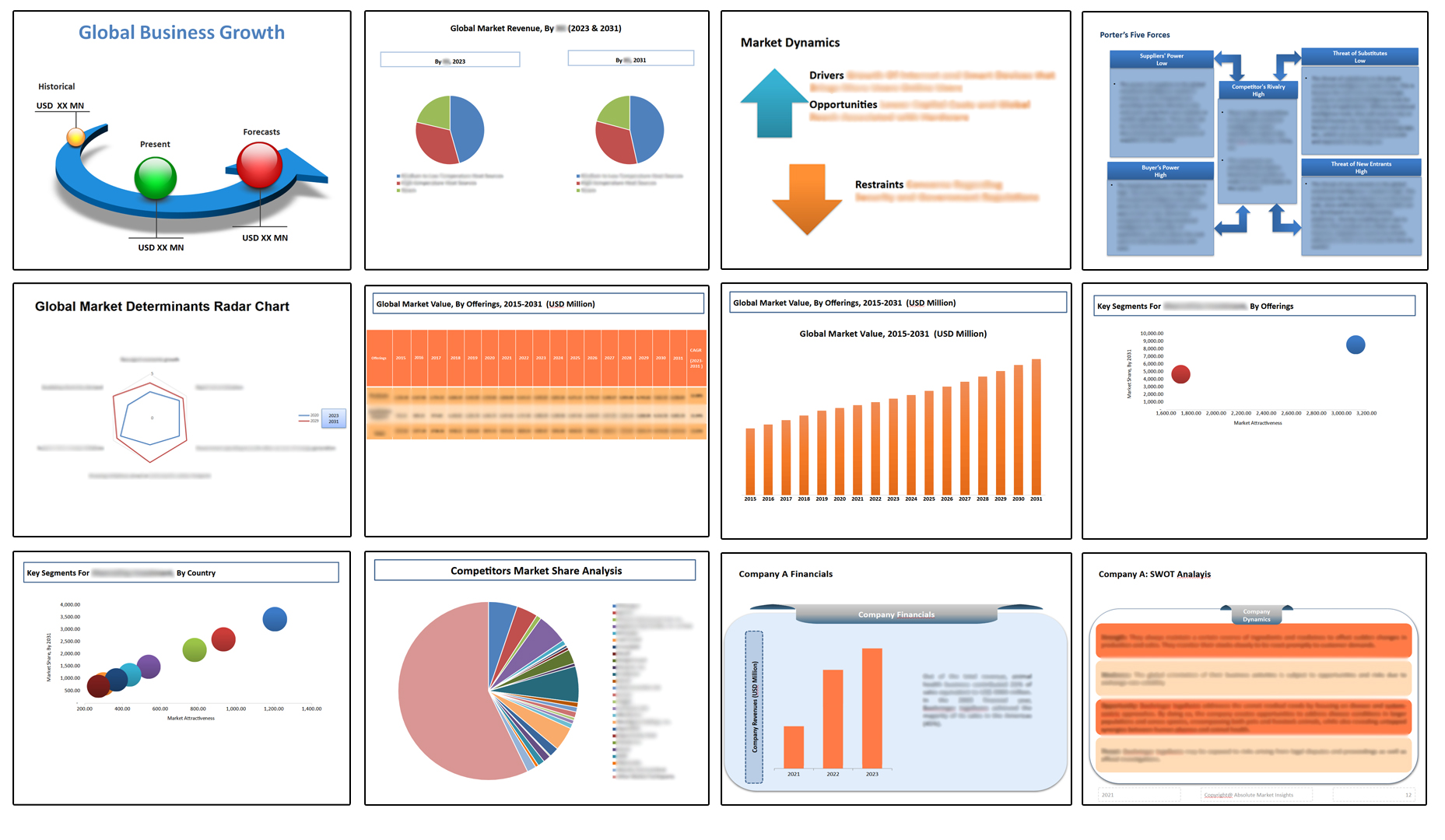
Table of Contents
Note: This ToC is tentative and can be changed according to the research study conducted during the course of report completion.
**Exclusive for Multi-User and Enterprise User.
Global Surveillance Market
By Component
- Hardware
- Cameras
- Sensors
- Recording Devices
- Others
- Software
- On Premises
- Cloud
- Hybrid
- Services
- Professional Services
- Managed Services
By Connectivity
- Wired
- Wireless
By Application
- Detection
- Investigation
- Management
- Security
- Others
By Industry Vertical
- Government and Defense
- Transportation
- Retail
- Healthcare
- IT and Telecommunication
- Banking and Finance
- Others
By Region
- North America (U.S., Canada, Mexico, Rest of North America)
- Europe (France, The UK, Spain, Germany, Italy, Nordic Countries (Denmark, Finland, Iceland, Sweden, Norway), Benelux Union (Belgium, The Netherlands, Luxembourg), Rest of Europe)
- Asia Pacific (China, Japan, India, New Zealand, Australia, South Korea, Southeast Asia (Indonesia, Thailand, Malaysia, Singapore, Rest of Southeast Asia), Rest of Asia Pacific)
- Middle East & Africa (Saudi Arabia, UAE, Egypt, Kuwait, South Africa, Rest of Middle East & Africa)
- Latin America (Brazil, Argentina, Rest of Latin America)
The Niche Research approach encompasses both primary and secondary research methods to provide comprehensive insights. While primary research is the cornerstone of our studies, we also incorporate secondary research sources such as company annual reports, premium industry databases, press releases, industry journals, and white papers.
Within our primary research, we actively engage with various industry stakeholders, conducting paid interviews and surveys. Our meticulous analysis extends to every market participant in major countries, allowing us to thoroughly examine their portfolios, calculate market shares, and segment revenues.
Our data collection primarily focuses on individual countries within our research scope, enabling us to estimate regional market sizes. Typically, we employ a bottom-up approach, meticulously tracking trends in different countries. We analyze growth drivers, constraints, technological innovations, and opportunities for each country, ultimately arriving at regional figures.Our process begins by examining the growth prospects of each country. Building upon these insights, we project growth and trends for the entire region. Finally, we utilize our proprietary model to refine estimations and forecasts.
Our data validation standards are integral to ensuring the reliability and accuracy of our research findings. Here’s a breakdown of our data validation processes and the stakeholders we engage with during our primary research:
- Supply Side Analysis: We initiate a supply side analysis by directly contacting market participants, through telephonic interviews and questionnaires containing both open-ended and close-ended questions. We gather information on their portfolios, segment revenues, developments, and growth strategies.
- Demand Side Analysis: To gain insights into adoption trends and consumer preferences, we reach out to target customers and users (non-vendors). This information forms a vital part of the qualitative analysis section of our reports, covering market dynamics, adoption trends, consumer behavior, spending patterns, and other related aspects.
- Consultant Insights: We tap into the expertise of our partner consultants from around the world to obtain their unique viewpoints and perspectives. Their insights contribute to a well-rounded understanding of the markets under investigation.
- In-House Validation: To ensure data accuracy and reliability, we conduct cross-validation of data points and information through our in-house team of consultants and utilize advanced data modeling tools for thorough verification.
The forecasts we provide are based on a comprehensive assessment of various factors, including:
- Market Trends and Past Performance (Last Five Years): We accurately analyze market trends and performance data from preceding five years to identify historical patterns and understand the market’s evolution.
- Historical Performance and Growth of Market Participants: We assess the historical performance and growth trajectories of key market participants. This analysis provides insights into the competitive landscape and individual company strategies.
- Market Determinants Impact Analysis (Next Eight Years): We conduct a rigorous analysis of the factors that are projected to influence the market over the next eight years. This includes assessing both internal and external determinants that can shape market dynamics.
- Drivers and Challenges for the Forecast Period:Identify the factors expected to drive market growth during the forecast period, as well as the challenges that the industry may face. This analysis aids in deriving an accurate growth rate projection.
- New Acquisitions, Collaborations, or Partnerships: We keep a close watch on any new acquisitions, collaborations, or partnerships within the industry. These developments can have a significant impact on market dynamics and competitiveness.
- Macro and Micro Factors Analysis:A thorough examination of both macro-level factors (e.g., economic trends, regulatory changes) and micro-level factors (e.g., technological advancements, consumer preferences) that may influence the market during the forecast period.
- End-User Sentiment Analysis: To understand the market from the end-user perspective, we conduct sentiment analysis. This involves assessing the sentiment, preferences, and feedback of the end-users, which can provide valuable insights into market trends.
- Perspective of Primary Participants: Insights gathered directly from primary research participants play a crucial role in shaping our forecasts. Their perspectives and experiences provide valuable qualitative data.
- Year-on-Year Growth Trend: We utilize a year-on-year growth trend based on historical market growth and expected future trends. This helps in formulating our growth projections, aligning them with the market’s historical performance.
Research process adopted by TNR involves multiple stages, including data collection, validation, quality checks, and presentation. It’s crucial that the data and information we provide add value to your existing market understanding and expertise. We have also established partnerships with business consulting, research, and survey organizations across regions and globally to collaborate on regional analysis and data validation, ensuring the highest level of accuracy and reliability in our reports.









